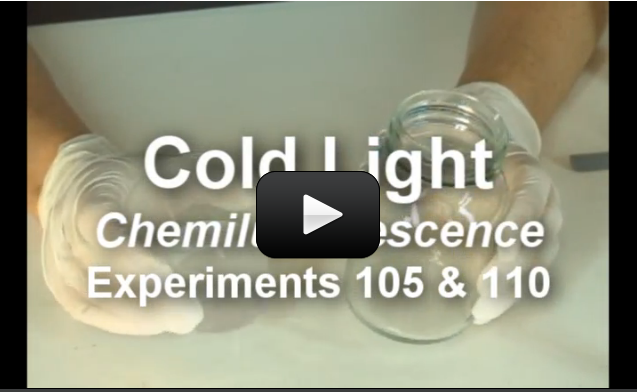This experiment is for advanced students.
Glo-sticks! Parents hang them from their trick or treaters, backpackers read with them light late at night in a tent. Glo-sticks work on the principle of chemiluminescence. Chemiluminescence is defined as emitting light without heat as the result of a chemical reaction.
[am4show have=’p8;p9;p11;p38;p92;p52;p80;’ guest_error=’Guest error message’ user_error=’User error message’ ]
We might be tempted to mistake cold light for fluorescence. Fluorescent light is created by exciting electrons, not from a chemical reaction.
Luminol is one of out chemicals in this lab. Luminol is most famous by its use by criminal investigators when they need to locate blood. What makes this happen is that the iron in the blood reacts with the luminol to generate cold light.
Let’s have fun creating our own little version of cold light….I’ll use the term “cold light” from now on. It takes a long time to type out “chemiluminescence”.
Materials:
- Glass jar
- Measuring cup
- Water
- Test tube
- Luminol C8H7N3O2 (MSDS)
- Sodium hydroxide NaOH (MSDS)
- Stir rod
- Hydrogen peroxide H2O2 (MSDS)
- Potassium hexacynoferrate II K3Fe(CN)6 (MSDS)
- Measuring spoon
The chemical reaction in this lab produces light without heat. Photons of light are emitted, but no heat. That must be cold heat. The light emitted from this lab is not as bright as a glow stick, but it still emits light. The same principle is used in the glow sticks. Our light will be seen as a low power blue-green light. The cold light effect is best viewed in a darkened room.
C3000: Experiments: 105, 110
Download Student Worksheet & Exercises
Here’s what’s going on in this experiment:
Solution #1 C8H7N3O2 + NaOH is added to Solution #2 H2O2 + K3Fe(CN)6 –> Cold Light
Cold Light is the production of light from a chemical reaction without the radiation of heat. There are three types of cold light reactions: Fluorescence, phosphorescence, and chemiluminescence. In chemiluminescence no radiation is absorbed. A chemical reaction provides the energy needed to emit light. Chemiluminescence is usually referred to as “cold light”. It rolls off the tongue much better and is easier to type. (I find that every time I type “chemiluminescence” I spell it differently.)
People used to rub their walking sticks with a luminescent jellyfish to light the path while walking. Today, light sticks from the store aren’t made from jellyfish. Modern-day light sticks involve a different reaction from the experiment you will be performing. We will have the luminal glow, but light sticks use a different reaction.
Light sticks use a di-ester of hydrogen peroxide that oxidizes in an organic solvent. The reaction is tons slower, giving a light stick a life span of hours instead of seconds or minutes. Dyes are added to produce different colors. When you break the class vial inside to activate the light stick, you mix the luminol with the other reactant, and the chemical reaction is under way.
A general chemical equation producing cold light:
A + B –> high energy intermediate à products + light
The luminol is oxidized by B. This oxidation produces cold light.
Cleanup: We are going to clean everything thoroughly after we finish the lab. After cleaning with soap and water, rinse thoroughly. Chemists use the rule of “three” in cleaning glassware and tools. After washing, chemists rinse out all visible soap and then rinse three times more.
Storage: Place cleaned tools and glassware in their respective storage places.
Disposal: Liquids can be washed down the drain. Solids are thrown in the trash.
[/am4show]

